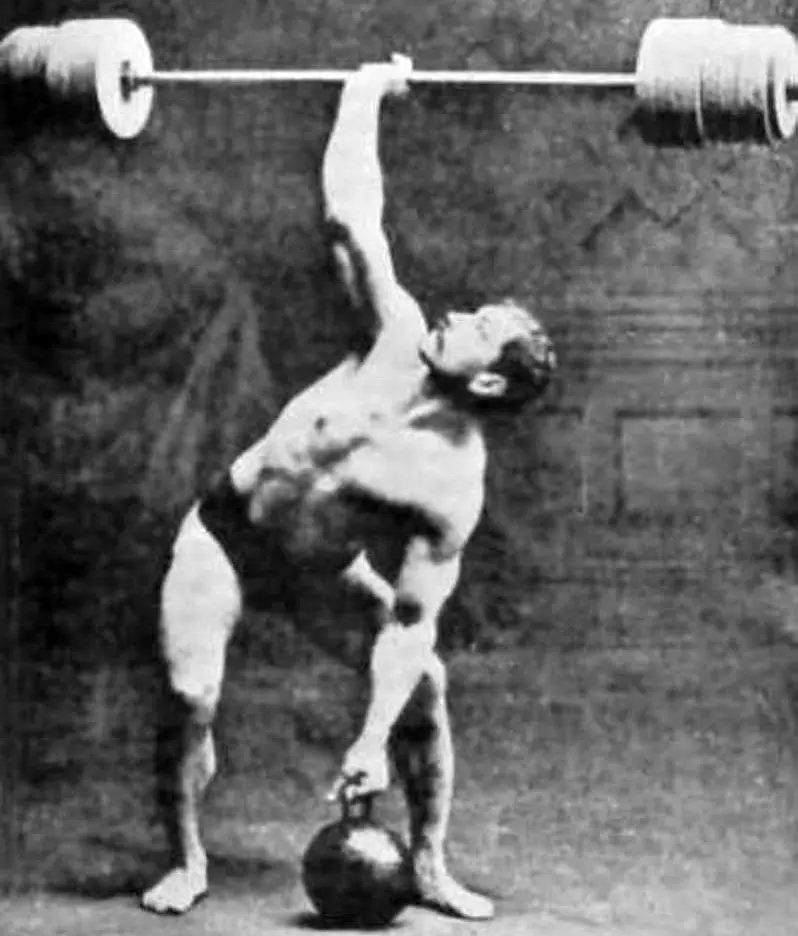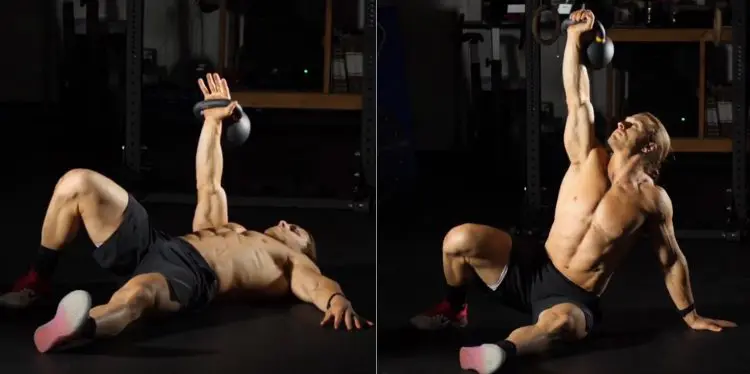The windmill is not a new exercise. In fact, it’s been around for hundreds of years. The strongmen of old used to do this movement with staggeringly heavy weights, and even while using mismatched apparatus like a barbell in one hand, and a kettlebell in the other, just to keep things interesting! To say these guys had cores of iron really would be an understatement.

A little more recently, there has been a renewed interest in this classic lift. It often features in kettlebell and CrossFit workouts.
In this guide, we reveal the benefits of the windmill and how to do it, also providing you with some variations and alternatives that you can use to keep your workouts fun and challenging.
Benefits and Muscles Worked
The windmill is very much a whole-body exercise. It works your upper body, core, and lower body, including major and minor muscle groups. This exercise also has several purposes and benefits. Doing windmills will:
- Build core strength
- Improve mobility and flexibility
- Increase shoulder stability
- Develop better coordination
- Improve balance
Windmills also teach you how to generate force in a stretched or awkward position. While this might seem like an unnecessary or unwanted benefit, for sports, it’s very useful. In sports, you’re often required to push or pull from less than optimal positions, such as while wrestling an opponent. This exercise helps cultivate this ability.
The main muscles worked during windmills are:
Level Up Your Fitness: Join our 💪 strong community in Fitness Volt Newsletter. Get daily inspiration, expert-backed workouts, nutrition tips, the latest in strength sports, and the support you need to reach your goals. Subscribe for free!
Deltoids and rotator cuff – the deltoids are the muscles on the outside of your shoulder joint, while the rotator cuff consists of the muscles below and within. The bigger deltoids are responsible for the main movements of your shoulder, whereas the rotator cuffs, consisting of supraspinatus, infraspinatus, teres minor, and subscapularis, are stabilizers that are also responsible for finer movement control. Windmills develop strength and mobility in these muscles.
Rhomboids and trapezius – these muscles, which are located on and across the scapulae, hold your shoulder blades down and back during windmills. These muscles are essential for posture, as well as shoulder joint stability.
Core – this is the collective term for the muscles that make up the midsection, including the rectus abdominis, obliques, and erector spinae, as well as the pelvic floor and diaphragm. These muscles work together to create intra-abdominal pressure to support your spine as you bend and twist during this lift.
Gluteus maximus – known as the glutes for short, this muscle is your major hip extensor. It’s especially active in this exercise as you bend forward and then stand back up again. In some ways, this action is not dissimilar to a stiff-legged deadlift or good morning.
Hamstrings – located on the back of your thigh, the hamstrings work with the glutes to control hip extension. If you find it hard to lean forward, this muscle may be tight. Subsequently, windmills are very good for improving dynamic hamstring flexibility.
How to Perform Windmills
To work the muscles listed, enjoy all the benefits of this exercise has to offer, and minimize your risk of injury, it’s crucial that you perform this exercise correctly. Using a light weight, follow this step by step guide to ensure that you get the best from this exercise, with none of the risks.
But, before trying windmills for yourself, make sure you warm up, so your body is prepared for the demands of what you are about to do. Start with a few minutes of light cardio to raise your core temperature, followed by some flexibility and mobility exercises for your shoulders, spine, and hips. Finish off with a few reps of bodyweight-only windmills to fully prepare your muscles and joints.
How to do Windmills:
- Stand with your feet about 1½ shoulder-widths apart. Hold your weight (dumbbell/kettlebell) in your right hand and raise it overhead. Your right foot should be directly beneath the weight, while your left leg should be angled outward, toes facing the same way as your knee.
- Pull your shoulders down and back and brace your abs. Place your left hand on your thigh, with your palm uppermost.
- Rotate your torso, so your left shoulder is turned down toward the floor. Push your hips to the right. Most of your weight should now be on your left leg. Turn your head and look up at the weight.
- Lean to the side and slide your left hand down your leg. Try to keep your right leg straight, bending your left leg only slightly. Continue looking up at the weight.
- Lean as far down as you can while reaching down your leg. You should feel a stretch in the back of your left leg and the right side of your torso. Focus on stabilizing the weight with your right shoulder.
- Contract your left hamstring and glute and stand up, untwisting your torso as you do so. Make sure you keep the weight stabilized overhead and your left hand against your leg as you stand up.
- Repeat for the desired number of repetitions, rest a moment, and then change sides.
Using too much weight too soon could have a disastrous effect, and even lead to serious injury, so practice with a light weight, or even without weights, until you have mastered the movement. Also, it’s perfectly normal to find one side harder than the other because of flexibility, stability, and/or strength imbalances.
Windmill Variations and Alternatives
Here are a few windmill variations and alternatives to try that will ensure your workouts are always fresh and interesting.
Low hold windmills
Instead of holding the weight overhead, hold it in your lowermost hand instead. This ensures your core gets a good workout without having to worry so much about stabilizing a weight overhead. This is a good variation for anyone with tight shoulders who cannot maintain a vertical arm while doing windmills.
Rack hold windmill
For this variation, rack and hold your weight on your shoulder instead of overhead. This makes windmills a little less shoulder-centric, but it’s still a good core exercise. This is a useful variation for anyone with inadequate shoulder mobility or stability.
Bottoms up kettlebell windmill
Performed as above but while holding a kettlebell vertically by the uppermost handle. This forces you to keep your loaded arm perfectly upright, and also increases the grip demand of this exercise.
Level Up Your Fitness: Join our 💪 strong community in Fitness Volt Newsletter. Get daily inspiration, expert-backed workouts, nutrition tips, the latest in strength sports, and the support you need to reach your goals. Subscribe for free!
Double weight windmill
Have you mastered regular windmills? Good for you! Make things harder by holding a dumbbell or kettlebell in both hands. This will increase the core demand for this exercise. You could also go fully old-school by holding different weight/size objects in each hand. This will really challenge your balance.
Barbell windmill
This is probably the hardest known version of the windmill exercise. Instead of a kettlebell or dumbbell, grip and hold the exact center of a barbell and raise it overhead. Even a small wobble will destabilize your shoulder and core. Only attempt this exercise is you have completely mastered regular windmills and have plenty of space around you!
Turkish get-ups
The TGU is similar to windmills in that it works your upper body, core, and lower body at the same time, and will develop strength, stability, and mobility in one movement. While these exercises are quite different, the windmill and the Turkish Get Up are equally effective and can be used as alternatives for one another.
Important Windmill Training Tips
Get the most from the windmill with these handy tips!
Build your base – the windmill is a complicated exercise, so you may need to break it down into smaller chunks to make it more achievable. Make sure you can do an overhead carry, side bends, and have reasonable flexibility before attempting this exercise. It goes without saying that this is not an exercise for beginners and that it is best left to experienced exercisers.
Don’t go down too far if you aren’t very flexible – in most windmill pictures and videos, you’ll see the model reaching all the way down to their ankle, foot, or even the floor. You do not have to copy them. Lean over as far as you feel comfortable, and work on increasing your range of motion over the coming weeks and months. If you can only reach your knee initially, that’s ok! Trying to go down too far too soon is an excellent way to get injured.
Practice windmills without weights – the more you practice this exercise, the sooner you’ll master it, but using weights all the time could lead to overtraining. Get around this issue by doing it without weights as often as you do it with them. That way, you can practice it daily, and even use the grease the groove method. Use weights just 1-2 times a week to avoid overuse injuries and overtraining.
Kettlebells may be easier to master – while you can do windmills with dumbbells, kettlebells are usually easier to handle. They hang down the back of your forearm, which shortens the lever and makes them easier to stabilize. Dumbbells sit in the palm of your hand, which makes them a little harder to control. If you are struggling to stabilize your arm, switching from dumbbells to kettlebells may help.
Train your weaker side first – if you notice that you have a left to right strength or mobility imbalance, always train your weaker side first. Then, when it’s time to work your stronger side, match that weight and number of reps. This will stop any performance gap from widening. Then do an extra set or two for your weaker side to help it catch up. In time, you should be able to eliminate any such imbalances.
Go shoeless – balance and weight distribution are critical for successful windmills. A thick, shock-absorbing pair of shoes prevents you from grounding your feet properly. If your gym allows it, try doing windmills barefooted. You should feel more stable as a result.
Use some chalk – you’ve got enough to think about during windmills without having to worry about sweaty, slippery hands. Chalk your palms so that your grip is secure. If you don’t have any chalk, make sure you wipe your hands on a towel at the start of each set. Wipe the kettlebell/dumbbell handle too.
Common Mistakes
Windmills are hard enough without the added difficulty of unnecessary mistakes. Avoid these slip-ups so you can make the most of this exercise and master it sooner.
Too heavy, too soon – master the movement before trying to lift heavy weights. Using too much weight too soon could stop you from ever learning this technically demanding exercise. Spend a few weeks working with light weights before you start trying to overload your muscles. That way, you are less likely to pick up the bad habits that lifting heavy weights can cause.
Not staying tense – this is a full-body exercise. If you relax any part of your body, from your feet to your hands, you risk losing stability. Practice generating tension all through your body. Plant your feet firmly on the floor and imagine you are gripping it. Tense your legs, core, chest, shoulders, and arms as you move. This is a sort of dynamic tension, which is a proven method for building strength.
Being impatient – very few people get the windmill right the first time. There is a lot to think about during this exercise! Take your time and don’t expect to do it perfectly the first time out. It may take several attempts before you start to feel comfortable and confident, and considerably longer than that to achieve any level of proficiency. Don’t give up if you find it challenging; after all, it’s the things we find hardest that often do us the most good.
Windmills: Wrapping Up
The windmill is an unusual exercise, but it’s not a new one. It’s part of strength training history and something that every lifter should try at least once. But this is no workout novelty. The windmill offers a long list of full-body benefits, and it’s one of the best core exercises around. If you want an iron waist, this is the exercise for you.
Like a lot of golden-era exercises and feats of strength, the windmill is not easy to master, but if you stick with it, you’ll love the results. So, if you want to build a super-strong midsection, incredible shoulder stability, and full-body flexibility, give the windmill a try.









